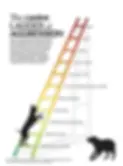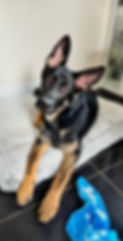
BLOG

Welcome to my blog! This is where I will be writing about every dog training & dog behaviour modification!
EMOTIONS DRIVE BEHAVIOUR
It is what it says on the tin. Emotions drive behaviour. This goes for pretty much everything, including our dogs and even ourselves. Have you ever been having a bad day and reacted to something in a way that you wouldn’t usually? This happens for our dogs too! If they are in a low mood state due to fear or stress (due to cortisol releases) for example, then they are far more likely to have a negative response to a trigger.
Dog’s behaviours are influenced by physiological processes that involve hormones and neurotransmitters – just like us! With training, it is important to aim to get those dopamine and serotonin releases to boost your dog’s mood state. This is why it is important to make training fun and exciting for your dog! Moving your dog towards fun and pleasure and away from fear and punishment will really help to boost these positive neurotransmitters.
To build their confidence, allow your dog to enjoy and have fun with training. Your dog will gain confidence quicker and be in a far better mental state that allows them to learn. When training, always provide your dog with choices, with reinforcement and with fun!
Training should be fun and exciting, not frustrating, scary and unsuccessful! This is why I always carry out an emotional assessment for my dog behaviour consultations. How your dog feels is important to me! Let's build their confidence!


DOG BODY LANGUAGE
Dog body language is always one of the first things that I go through with my clients. It is so important. Your dog’s body language is their way of communicating with you. If we do not understand their body language, how are we supposed to know when and what they are communicating?
I am sure you have seen a dog with their ears held back, their head lowered and their tail under their bum. These are all signs of a dog being uncomfortable. However, there are even more subtle signs that your dog is worried. There is something called The Ladder of Aggression in the dog world and it is the body language a dog will show us, to communicate that they are worried or uncomfortable.
When I say subtle, it can be as discreet as blinking. The whole idea of the ladder of aggression is that, if we catch the body language at the bottom of the ladder, then your dog should not feel the need to escalate up the ladder. Sometimes, when we do not notice these subtleties, then your dog may learn that their communication must start at growling or freezing rather than blinking and lip licking, if this wasn’t noticed previously.
Please take note of the ladder and see if you can notice any of this body language in your dogs! We always expect them to understand what we are saying and so it is important that we understand what they are saying to us too!
FOOD ENRICHMENT
Let’s talk about food enrichment! When I say food enrichment, do you know what I mean? Some people don’t and that is absolutely ok. I am here to explain all.
Food enrichment can come in many forms and here are but a few examples:
-
Kongs
-
Snuffle mats
-
Lickimats
-
Slow feeders
-
Slow feeder balls
-
Scatter feeding in a room or garden
-
Cardboard boxes
-
Wobble Kongs
-
Kong Quizzers
-
Cardboard boxes
My tutor once said to me “…a food bowl is a wasted opportunity…”. Ever since this, I have become a huge advocate for food enrichment for our dogs and let me explain why. Not only does food enrichment slow our dog’s eating down and prevent the unfortunate possibility of gastric torsion/bloat, but it is very mentally stimulating for our dogs to do.
When they get into food enrichment, our dogs are having to use their pre-frontal cortex (the decision-making part of their brain) to figure out how to get to the food. This is fantastic at keeping them busy, building impulse control, building your dog's confidence and helping them relax. Food enrichment is fantastic at releasing serotonin and oxytocin into your dog's brain to help them feel calm and relaxed.
Many of my clients have seen huge improvements in their dogs, just by introducing food enrichment alone. I recommend using as much enrichment with your dog's meals as possible and do not forget about all natural chews!


MY THOUGHTS ON AVERSIVES, E-COLLARS & PRONG COLLARS
This is a bit more of a serious post today, but something that is important for our wonderful industry and dogs.
If you don’t know, I own two dogs, a little crossbreed (we believe to be terrier x chihuahua, but who knows!) called Nellie and a Pomeranian called Hovis. When I first got Nellie, she was incredibly fearful and reactive to pretty much everything, but especially towards strangers and even more so if they were men.
My behaviour and training methods are known as positive reinforcement and force/fear free. This means I am always considering a dog’s emotions as well as any pains or discomforts that the dog may be going through and always using the latest scientific research. Not only this, but I pride myself on changing a dog’s emotional response to a trigger. For example, my aim is to help your dog learn that people coming into the home bring fun and food, instead of fear and over-handling.
When a dog is reacting to a trigger (e.g. barking & lunging), they will have a large increase in their adrenaline and cortisol (stress hormone) levels which means they will be in a lower mood state and feeling stressed. When a dog is in a low mood state and stressed, their ability to learn is nearly non-existent because they are trying to prioritise their safety, and so successful dog training and behaviour modification will struggle to take place. In fact, when a dog feels like this, they are far more likely to react negatively and add another negative interaction to their reinforcement history.
More and more regularly, I am seeing ‘trainers’ (and many without any qualifications – please do your research on your trainers!) using certain methods and especially equipment that can be detrimental to a dog and their behaviour modification and/or training journey. This can include the use of e-collars, prong collars and slip leads as well as corrections.
The reason I don’t and will never use or recommend these for any of my clients is because you are essentially fighting fire with fire. This is called positive punishment whereby we add something (e.g. a correction) in order to decrease a behaviour. Adding something to prevent a behaviour can only be caused by pain/discomfort or fear and anticipation of the pain/discomfort. So when we see these ‘quick fixes’ that includes these tools and methods, what we are actually seeing is a very scared and behaviourally suppressed dog that is doing what they can in order to avoid that pain/discomfort again.
If I was to have used these methods with Nellie, she would have learned to associate her triggers with pain/discomfort, fear and consequence, instead of something positive like food, a toy or even praise. Many dogs have come to me after having this type of training because their behaviour got worse after those methods and unfortunately, a lot end up losing a trusting relationship with their guardians.
Instead, I use reward and fun to reinforce the right behaviours, increase the dog’s mood state and build their confidence. It is all about building a solid, positive reinforcement history, teaching your dog new patterns of behaviours and taking their training journey, at their pace! This is what will build your relationship with your dog, build a positive association to their triggers and help them to be a happy, confident dog! The right training takes time and is never an overnight fix. But we are all here for the journey with you!
Do not forget, whenever your dog shows a negative reaction, they are just having some big feelings and need our help!


